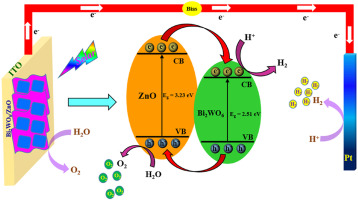当前位置:
X-MOL 学术
›
J. Environ. Manag.
›
论文详情
Our official English website, www.x-mol.net, welcomes your feedback! (Note: you will need to create a separate account there.)
ZnO nanosheets-decorated Bi2WO6 nanolayers as efficient photocatalysts for the removal of toxic environmental pollutants and photoelectrochemical solar water oxidation.
Journal of Environmental Management ( IF 8.7 ) Pub Date : 2020-04-06 , DOI: 10.1016/j.jenvman.2020.110504 Ravindranadh Koutavarapu 1 , Bathula Babu 1 , Ch Venkata Reddy 1 , I Neelakanta Reddy 1 , Kakarla Raghava Reddy 2 , M C Rao 3 , Tejraj M Aminabhavi 4 , Migyung Cho 5 , Dongseob Kim 6 , Jaesool Shim 1
Journal of Environmental Management ( IF 8.7 ) Pub Date : 2020-04-06 , DOI: 10.1016/j.jenvman.2020.110504 Ravindranadh Koutavarapu 1 , Bathula Babu 1 , Ch Venkata Reddy 1 , I Neelakanta Reddy 1 , Kakarla Raghava Reddy 2 , M C Rao 3 , Tejraj M Aminabhavi 4 , Migyung Cho 5 , Dongseob Kim 6 , Jaesool Shim 1
Affiliation

|
Herein we report the fabrication of novel Bi2WO6/ZnO heterostructured hybrids for organic contaminant degradation from wastewater and photoelectrochemical (PEC) water splitting upon solar illumination. The Bi2WO6/ZnO photocatalysts were synthesized using a simple and eco-friendly hydrothermal process without the support of any surfactants. From the photocatalytic experiments, heterostructured Bi2WO6/ZnO nanohybrid catalysts exhibited considerably better photocatalytic performance for rhodamine B (RhB) degradation under solar illumination. The BWZ-20 nanocomposite demonstrated superior photodegradation of RhB dye up to 99% in about 50 min. Furthermore, BWZ-20 photoelectrode showeda lower charge-transfer resistance than other samples prepared, suggesting its suitability for PEC water splitting. The photocurrent densities of Bi2WO6/ZnO photoelectrodes were evaluated under the solar irradiation. The BWZ-20 photoelectrode exhibited a significant photocurrent density (0.45 × 10-3A/cm2) at +0.3 V vs. Ag/AgCl, which was~1036-times higher than that of pure Bi2WO6, and ~4.8-times greater than the pure ZnO. Such improved photocatalytic and PEC activities are mainly attributed to the formation of an interface between ZnO and Bi2WO6, superior light absorption ability, low charge-transfer resistance, remarkable production of charge carriers, easy migration of charges, and suppression of the recombination of photogenerated charge carriers.
中文翻译:

ZnO纳米片装饰的Bi2WO6纳米层可作为有效的光催化剂,用于去除有毒的环境污染物和光电化学太阳能水氧化。
本文中,我们报道了新型Bi2WO6 / ZnO异质结构杂化体的制备,该杂化杂化体用于从废水和太阳光照射下的光电化学(PEC)水分解中降解有机污染物。Bi2WO6 / ZnO光催化剂是使用简单且环保的水热工艺合成的,无需任何表面活性剂的支持。从光催化实验来看,异质结构的Bi2WO6 / ZnO纳米杂化催化剂在日光照射下对若丹明B(RhB)的降解表现出明显更好的光催化性能。BWZ-20纳米复合材料在约50分钟内表现出了出色的RhB染料光降解率,最高可达99%。此外,BWZ-20光电极显示出比其他制备的样品更低的电荷转移电阻,表明其适用于PEC水分解。在太阳辐射下评价Bi 2 WO 6 / ZnO光电极的光电流密度。BWZ-20光电极在+0.3 V时相对于Ag / AgCl表现出显着的光电流密度(0.45×10-3A / cm2),比纯Bi2WO6高约1036倍,比纯Bi2WO6高约4.8倍。纯ZnO。这种改善的光催化和PEC活性主要归因于ZnO和Bi2WO6之间的界面的形成,优异的光吸收能力,低的电荷转移阻力,显着的电荷载流子生成,电荷易于迁移以及抑制了光生电荷的重组运营商。比纯ZnO高约4.8倍。这种改善的光催化和PEC活性主要归因于ZnO和Bi2WO6之间的界面的形成,优异的光吸收能力,低的电荷转移阻力,显着的电荷载流子生成,电荷易于迁移以及抑制了光生电荷的重组运营商。比纯ZnO高约4.8倍。这种改善的光催化和PEC活性主要归因于ZnO和Bi2WO6之间的界面的形成,优异的光吸收能力,低的电荷转移阻力,显着的电荷载流子产生,电荷易于迁移以及抑制了光生电荷的重组运营商。
更新日期:2020-04-06
中文翻译:

ZnO纳米片装饰的Bi2WO6纳米层可作为有效的光催化剂,用于去除有毒的环境污染物和光电化学太阳能水氧化。
本文中,我们报道了新型Bi2WO6 / ZnO异质结构杂化体的制备,该杂化杂化体用于从废水和太阳光照射下的光电化学(PEC)水分解中降解有机污染物。Bi2WO6 / ZnO光催化剂是使用简单且环保的水热工艺合成的,无需任何表面活性剂的支持。从光催化实验来看,异质结构的Bi2WO6 / ZnO纳米杂化催化剂在日光照射下对若丹明B(RhB)的降解表现出明显更好的光催化性能。BWZ-20纳米复合材料在约50分钟内表现出了出色的RhB染料光降解率,最高可达99%。此外,BWZ-20光电极显示出比其他制备的样品更低的电荷转移电阻,表明其适用于PEC水分解。在太阳辐射下评价Bi 2 WO 6 / ZnO光电极的光电流密度。BWZ-20光电极在+0.3 V时相对于Ag / AgCl表现出显着的光电流密度(0.45×10-3A / cm2),比纯Bi2WO6高约1036倍,比纯Bi2WO6高约4.8倍。纯ZnO。这种改善的光催化和PEC活性主要归因于ZnO和Bi2WO6之间的界面的形成,优异的光吸收能力,低的电荷转移阻力,显着的电荷载流子生成,电荷易于迁移以及抑制了光生电荷的重组运营商。比纯ZnO高约4.8倍。这种改善的光催化和PEC活性主要归因于ZnO和Bi2WO6之间的界面的形成,优异的光吸收能力,低的电荷转移阻力,显着的电荷载流子生成,电荷易于迁移以及抑制了光生电荷的重组运营商。比纯ZnO高约4.8倍。这种改善的光催化和PEC活性主要归因于ZnO和Bi2WO6之间的界面的形成,优异的光吸收能力,低的电荷转移阻力,显着的电荷载流子产生,电荷易于迁移以及抑制了光生电荷的重组运营商。



























 京公网安备 11010802027423号
京公网安备 11010802027423号